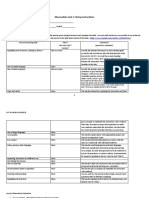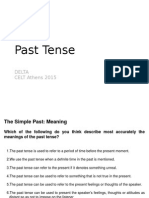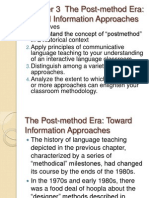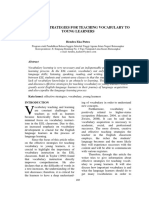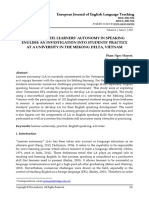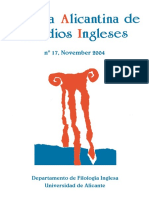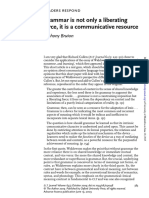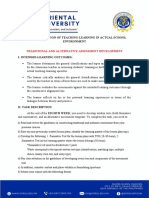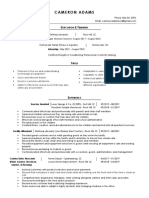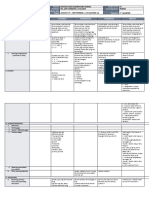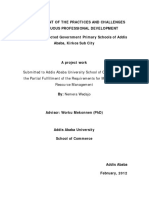ELT in Practice EDUM135
Observation task 3: Presentation and Practice of New Language
Observer: __________________________ Date:____________________________
Student No: _______________ Level:___________________ Length:_____________
The objective of this observation task is to look at how new language is presented, practice activities
and how they facilitate the use of new language.(https://www.youtube.com/watch?v=Niel3vqgwrU)
In this video, the new language point of 2nd conditional is introduced. Write brief notes on the
following while you observe. (Grammar teaching starts around 23”)
Presentation of New Language
What context does the teacher set? Does it naturally generate the target language?
The teacher began her class by presenting a picture of two people in a conversation. To activate
her students’ schemata and engage them into the lesson, she elicited suggestions about the
context of the picture, asking questions about the interlocutors’ relationship, what might be
happening in the picture and what the content of their conversation might be about. She also put
students in pair to discuss, which allows them to produce the target language naturally.
.
What are the means of presentation? Is it appropriate to the target language?
The main method of presentation that the teacher used was the interactive board. She also made
used of realias (the wallet, the note), pictures and audio to facilitate her lesson. Personally, I think
that the interactive board is appropritate to introduce the new language, the 2 nd conditional. Firstly,
it allows the teacher to structure her lesson clearly and logically. She could also highlight crucial
language features such as the structure of the 2 nd conditional. Secondly, the interactive board allows
much more dynamic and graphical capabilities than the traditional board, which is motivating and
helps engage the students in the learning process.
What features were highlighted at the white board/interactive board analysis? How did the teacher
involve the students in this stage?
The teacher introduced vocabulary that might cause difficulty for students in the listening
comprehension text. She used the interactive board to hightlight the spelling, the type of word
and the pronunciation of these vocabulary. Before that, the teacher utilised realias (the wallet)
and pictures to elicit the meanings of the lexis.
Regarding the introduction of new grammatical features, she used the interactive board to
highlight the sentence structure of the 2nd conditional, the word order, the use of contractions (I’d
� ELT in Practice EDUM135
– I would) and the verb tenses. To draw students’ attention to areas of possible mistakes such as
the use of past simple and the contraction form, the teacher used a finger techinique and
highlighted these features on the board with different colors. She also introduced the negative
and interrogative form of the 2nd conditional.
Practicing of New Language
For the practice activities, comment on the following:
Accuracy practice Fluency practice
Context The teacher developed the activities The teacher developed the activities
around the context arising from the around the context arising from the picture
(Was there a context for the picture given in the beginning of the given in the beginning of the lesson.
task?) lesson.
However, the second activity in which
students were required to put the
correct form of the verbs in the blank
was rather isolated.
Usefulness The activities were useful for the The activities were useful for students
students because they had the chance because it allows them to produce the
(Meaningful? Authentic? to practice the form of the new target language naturally. These tasks are
Interactive?) grammatical features. However, these also interactive because the students had
activities were not very interactive and the chance to practice in pair and in group.
authentic.
Instructions / modelling of task The teacher gave clear instructions for The teacher gave clear instructions for the
(Clear? Checked?) the activities. She used concise and activities. She used concise and simple
simple languages, gave examples and languages, gave examples and modeled her
modeled her instruction. However, she instruction. However, she did not ask
did not ask concept-check questions to concept-check questions to make sure
make sure students understand her students understand her instruction. There
� ELT in Practice EDUM135
instruction. was a point when the students seemed to
be unclear and she had to repeat her
instruction (42:49’).
Level of challenge (Too easy / Personally, I think that the accuracy The level of challenge of the fluency tasks
difficult? Motivating?) practice tasks are rather traditional presented in the lesson was motivating and
and not very motivating. All the tasks meaningful for the students. Students had
are somewhat similar in nature, they the chance to produce natural languages
all require students to form sentences that contain the target grammatical
by manipulating the given verbs. features. More precisely, students were
asked to give their personal answers and
explain the reasons for their choices. In the
last activity, the situations on the card
closely represents the situations students
might face in real life.
Nature of interaction The first accuracy practice task (choral The first fluency practice task: in pair
(Individual /pair /group) drilling): with the whole class
The second fluency practice task: in a
The second task (gap-filling with group
affirmative form): individual
The final task (gap-filling with
interrogative form): in a group
Time spent on task The time spent on the accuracy The time spent on the fluency practice
(Appropriate? Too rushed? Too practice tasks was approriate. There tasks was appropriate. Students had
long?) was enough time for the students to enough time to practice in groups while
work on the task individually or in pair, the teacher monitor discreetly and gave
check their answers with each other, feedback and suggestions.
and verify their answers with a
controlled check with the teacher.
�ELT in Practice EDUM135
ADITIONAL NOTES
Overall, this was a successful lesson. The teacher structured her lesson logically and provided students
with a variety of tasks that allow them to develop both their accuracy and fluency. She had good voice
quality, good eye contact, gestures and body languages and was able to engage the students in her lesson.
She also successfully employed visual aids such as the interactive board, realias, pictures to faciliate
students’ learning process. What I am extremely impressed with in her lesson is the use of finger
technique to draw students to the form and the pronunciation of the contraction “I’d – I would”.
However, in my opinion, there were two elements that made the lesson less successful. The first one is
that in giving instruction, the teacher did not check her students’ understanding, and did not give them a
clear starting signal. Secondly, the accuracy practice tasks were not very interactive and engaging.
